The Intel Broadwell Review Part 2: Overclocking, IPC and Generational Analysis
by Ian Cutress on August 3, 2015 8:00 AM ESTGenerational Tests: Office and Web Benchmarks
For this review, as mentioned on the front page, we retested some of the older CPUs under our new methodology. We did this testing at stock frequency as well as the IPC testing to see the ultimate real world result when you add in HyperThreading and frequency into the mix. If you recall back in our Devil’s Canyon i7-4790K review, the new high 4.4 GHz frequency of the i7-4790K was a tough one to beat for the newer architecture purely because any IPC gains are nullified by the older processor having a lot more frequency. With the Broadwell based i7-5775C being at 3.7 GHz and only 65W, this is a tough task. But what about if you are still running the Sandy Bridge based i7-2600K?
Some users will notice that in our benchmark database Bench, we keep data on the CPUs we’ve tested back over a decade and the benchmarks we were running back then. For a few of these benchmarks, such as Cinebench R10, we do actually run these on the new CPUs as well, although for the sake of brevity and relevance we tend not to put this data in the review. Well here are a few of those numbers too.
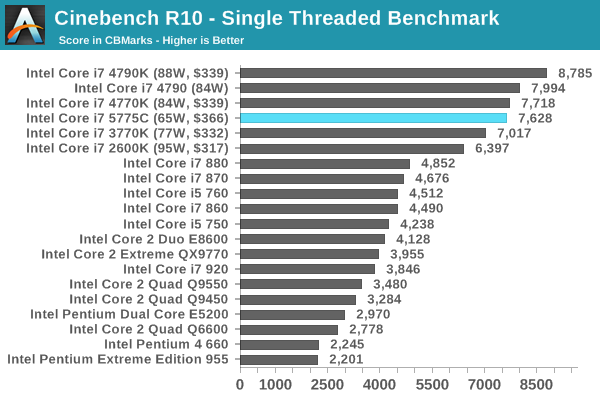
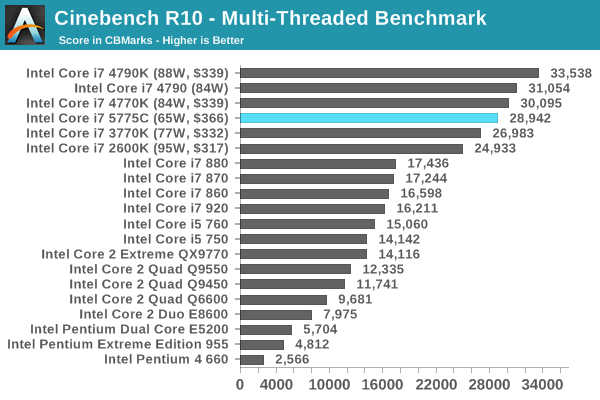


With some of these benchmarks, due to applications using new instruction sets, having the newer processors with the new instructions can make a lot of difference. Even in Cinebench R10, moving from the Core 2 Quad Q9550 to a Broadwell can get a 2.5x speed-up in this old software.
For the rest of our CPU benchmarks, here is what the landscape looks like with the most recent architectures. All of our benchmark results can also be found in our benchmark engine, Bench.
Office Performance
The dynamics of CPU Turbo modes, both Intel and AMD, can cause concern during environments with a variable threaded workload. There is also an added issue of the motherboard remaining consistent, depending on how the motherboard manufacturer wants to add in their own boosting technologies over the ones that Intel would prefer they used. In order to remain consistent, we implement an OS-level unique high performance mode on all the CPUs we test which should override any motherboard manufacturer performance mode.
Dolphin Benchmark: link
Many emulators are often bound by single thread CPU performance, and general reports tended to suggest that Haswell provided a significant boost to emulator performance. This benchmark runs a Wii program that raytraces a complex 3D scene inside the Dolphin Wii emulator. Performance on this benchmark is a good proxy of the speed of Dolphin CPU emulation, which is an intensive single core task using most aspects of a CPU. Results are given in minutes, where the Wii itself scores 17.53 minutes.

WinRAR 5.0.1: link
Our WinRAR test from 2013 is updated to the latest version of WinRAR at the start of 2014. We compress a set of 2867 files across 320 folders totaling 1.52 GB in size – 95% of these files are small typical website files, and the rest (90% of the size) are small 30 second 720p videos.
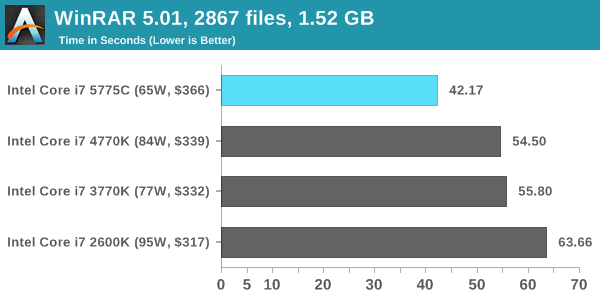
3D Particle Movement
3DPM is a self-penned benchmark, taking basic 3D movement algorithms used in Brownian Motion simulations and testing them for speed. High floating point performance, MHz and IPC wins in the single thread version, whereas the multithread version has to handle the threads and loves more cores.
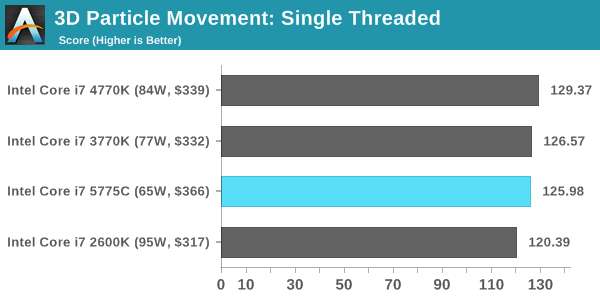
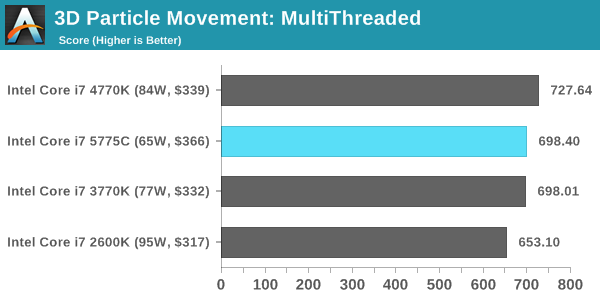
FastStone Image Viewer 4.9
FastStone is the program I use to perform quick or bulk actions on images, such as resizing, adjusting for color and cropping. In our test we take a series of 170 images in various sizes and formats and convert them all into 640x480 .gif files, maintaining the aspect ratio. FastStone does not use multithreading for this test, and results are given in seconds.
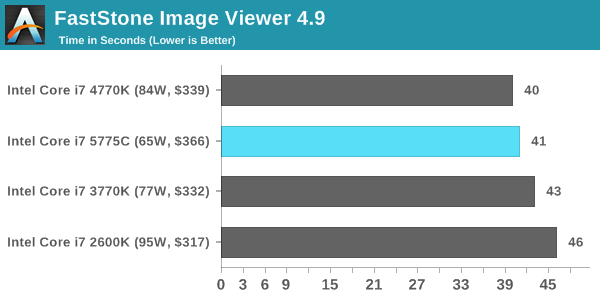
Web Benchmarks
On the lower end processors, general usability is a big factor of experience, especially as we move into the HTML5 era of web browsing. For our web benchmarks, we take four well known tests with Chrome 35 as a consistent browser.
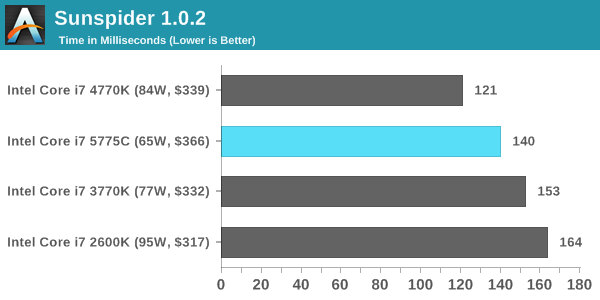
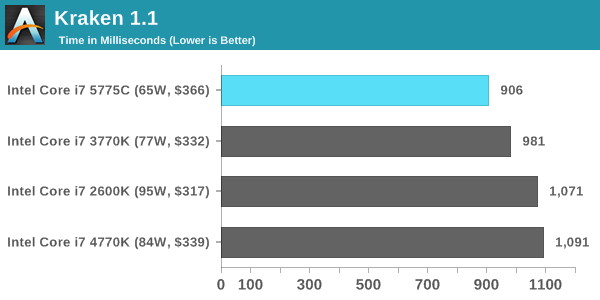
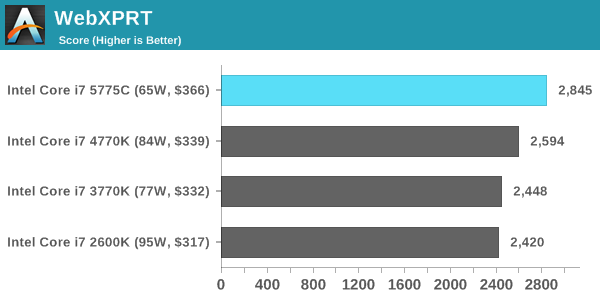
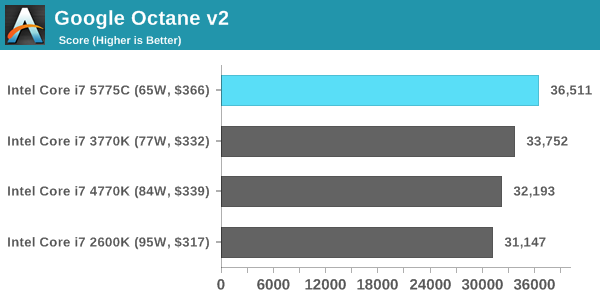










121 Comments
View All Comments
doggface - Tuesday, August 4, 2015 - link
Can intel please bring out a processor that destroys Sandy Bridge so that I don't have to hear all the smug comments every time they release a processor. I am so bored by them. Cant we talk about something interesting, like why is crystal well such a big focus for them when apparently all anyone wants in the enthusiast bracket is raw power?jrs77 - Tuesday, August 4, 2015 - link
And now look at all the PC-users who don't play games, but use their PCs for doing actual work.No tests of professional graphics software like Photoshop, Premiere, etc. No tests of professional audio-software like Reason, CuBase, etc. No tests of professional 3d-software that actually would benefit from the IrisPro and it's GPGPU-capabilities - and no, Cinebench is only for CPU-based rendering, so it doesn't count that much for stuff like flowsimulations done in Solidworks etc.
The i7-5775C is currently the best CPU outthere for small workstations, due to the very powerful IrisPro and the low TDP. You can build a very powerful rig in a box as small as the MacMini while still keeping the advantage of the 4C/8T CPU and an iGPU as powerful as a R7-250/GT740.
And this rig would only draw some 150W under full load, which is totally doable with a picoPSU.
I'm getting my i7-5775C finally delivered sometime next week, after waiting for 2 month, and I can finally build the rig I've allways wanted to combined with the following: Antec ISK110, picoPSU 160XT, Noctua NH-L9i, 2x SSD (256/512 GB) and 16GB DDR3.
Strapped to the back of my screen, allmost inaudible and very low power-draw.
This CPU is ment for SFF-workstations, but for this niche it's the best there is.
MrSpadge - Tuesday, August 4, 2015 - link
Thanks for the detailed review, Ian! As far as I know it's the most detailed out yet. And probably the last one, with Skylake hopefully just around the corner.Anyway, I would really like to see how low the power consumption of this chip can go. It's obviously optimized for mobile and low clocks, so pushing it to high clocks and high voltages (even the stock voltage is a lot for 14 nm!) is not showing it in its best light. When you tested the voltage scaling I would really like to see the minimum voltage needed to get to the lower speeds (you just left it at stock). How low can the power consumption of this chip become at ~1.0 V? Which clock speed hit does it take to get there? (btw: I run my 3770K at 4.0 GHz and a bit over 1.0 V, which is great for 24/7 load)
zlandar - Tuesday, August 4, 2015 - link
No reason to replace my 4 year-old i7-2600k for gaming. Kinda nutty since I just installed my 3rd video card on the same system.joanwa - Tuesday, August 4, 2015 - link
Concerning the Linux Performance, could one kindly ask for another software to be benchmarked? NAMD is nice, but the to my knowledge the bigger share of the scientific community in molecular dynamics uses Gromacs (www.gromacs.org), which is also much faster and better optimized for current Hardware (AVX2 support for instance, multiple GPU support) and has a bigger community around it.Morg72 - Tuesday, August 4, 2015 - link
I'm still rockin' an i7-950, ASUS P6X58D-E, 12gb DDR3 1600 and 2x 6870's in Crossfire. The only part showing me its age is the 6870's (probably going to upgrade next GPU gen). The rest runs everything I throw at it perfectly and that's at stock speed. I can always get a better CPU cooler and OC it for more longevity. Intel really needs to get things together. Hope Zen gives them a push.nagi603 - Wednesday, August 5, 2015 - link
4770k owner here... If this is how Intel upgrades, I won't be changing this baby out for a decade.Lazn_W - Wednesday, August 5, 2015 - link
My question is: Does the L4 cache help with multi threaded use? Say a home Hyper-V server lab environment? It might make the 5775C a better buy than one of the hex core 2111 socket CPUs..Jetpil0t - Thursday, August 6, 2015 - link
They should put out a multi-threaded K series 4 core with no IGP at a basement price for the more value minded people, gamers specifically, especially considering the main purpose of upgrading are the tertiary features on the motherboard. I doubt anyone with a Sandy is looking at this with any interest. Especially considering my Sandy board has PCIe3.0 and Sata 6Gbps and rocks 4-4.5 Ghz easily.SanX - Friday, August 7, 2015 - link
Big fart of Intel.Remember AMD Bulldozer?
Heads will be rolling.